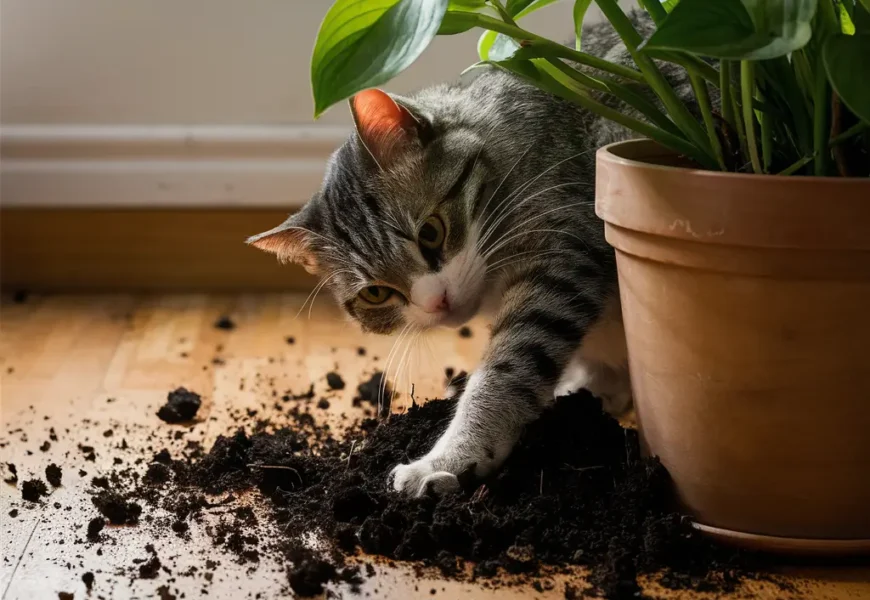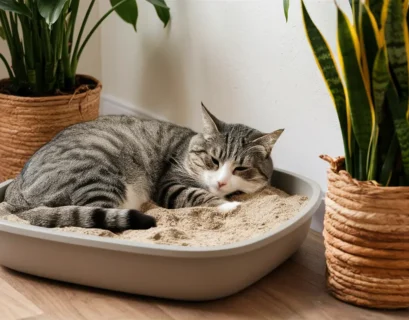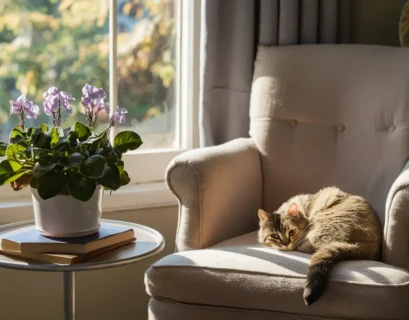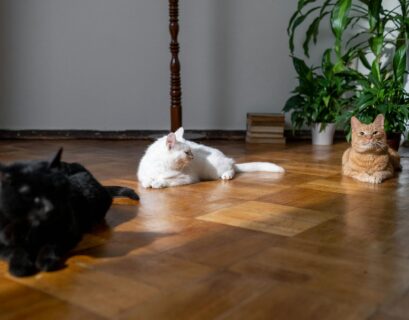Presence of houseplants brings not just aesthetic appeal but also numerous health benefits and a sense of tranquility. So, how to stop your cat from digging houseplants?
As discussed in my previous article “Pet-Friendly Plants: A Guide to Creating Harmony Between Pets and Houseplants”, understanding and addressing our pets’ natural behaviors is key to fostering a harmonious environment.
Table of Content
- I. Importance of Houseplants in Homes
- II. Understanding Cat Behavior
- III. Addressing Cat Behavior
- IV. Creating Harmony
- V. Conclusion
- FAQs
Let’s explore the importance of houseplants in our homes and the unique challenges posed by our cats digging houseplants
I. Importance of Houseplants in Homes
Houseplants have become more than just decorative elements; they’ve become essential components of modern living spaces.
As highlighted in “Top 10 Houseplant Trends to Spruce Up Your Home in 2024”, incorporating greenery into our indoor environments is not only on-trend but also promotes a sense of well-being and connection with nature.
From succulents adorning windowsills to towering monstera plants gracing living room corners, each plant adds its unique touch of vitality and style.
II. Understanding Cat Behavior
Cats, with their curious and playful nature, often view houseplants as intriguing additions to their indoor territory.
As explored in my post “How to Stop Your Dog or Cat from Digging Houseplants”, it’s crucial to comprehend the motivations behind their interactions with our green companions.
Instinctual behaviors such as digging and exploring are deeply ingrained in their nature, stemming from their evolutionary history as hunters and explorers.
A. Instinctual Digging Behavior in Cats
Digging is a natural behavior exhibited by cats, rooted in their primal instincts to hunt, hide, and mark their territory. In the wild, cats dig to bury their waste, seek out prey, or create comfortable resting spots.
When transplanted into our homes, this behavior often manifests in their interaction with houseplants, leading to unintended consequences for both the plants and their owners.
B. Motivations Behind Cat’s Interaction with Houseplants
Understanding the underlying motivations driving cats to engage with houseplants is crucial in devising effective strategies for coexistence. Several factors contribute to their fascination with indoor greenery, including:
- Seeking Comfortable Resting Spots: Cats are drawn to soft and cozy environments for lounging and napping. Houseplants, with their lush foliage and inviting nooks, often serve as irresistible resting spots for our feline companions.
- Hiding Litter: In multi-pet households or cramped living spaces, cats may view houseplants as convenient hiding spots for their litter, seeking privacy and seclusion for their bathroom activities.
- Curiosity Towards Textures and Rustling Leaves: Cats are naturally curious creatures, attracted to textures and sounds that stimulate their senses. The rustling leaves and varied textures of houseplants pique their curiosity and provide sensory enrichment.
- Attention-Seeking Behavior: Cats may engage in plant-related mischief as a means of seeking attention from their owners, especially if they feel neglected or bored. Knocking over potted plants or nibbling on foliage can be their way of signaling their need for interaction and stimulation.
III. Addressing Cat Behavior
Now that we’ve gained insights into the motivations driving our feline friends’ interaction with houseplants, it’s time to explore practical strategies for mitigating their impact while fostering a harmonious living environment for both cats and plants.
A. Providing Enrichment to Curb Boredom-Induced Digging
1. Regular Playtime and Interaction
Engaging in interactive play sessions with your cat is essential for channelling their energy and preventing boredom-induced behaviors like excessive digging.
Interactive toys such as feather wands, laser pointers, and puzzle feeders are excellent tools for stimulating their physical and mental faculties.
As discussed in “Pets & Plants: Happy Home Hacks for You & Your Dog”, dedicating dedicated playtime sessions strengthens the bond between you and your furry companion while redirecting their attention away from houseplants.
2. Use of Interactive Toys
Investing in a variety of interactive toys tailored to your cat’s preferences can provide much-needed mental stimulation and enrichment.
Toys that mimic natural prey movements, encourage chasing and pouncing, or dispense treats reward your cat’s natural hunting instincts and help alleviate boredom.
B. Designated Digging Spots for Cats
1. Providing Scratching Posts
Scratching is an innate behavior in cats, vital for maintaining healthy claws and marking territory.
By providing sturdy and enticing scratching posts throughout your home, you offer your cat an appropriate outlet for their digging and scratching instincts. Opt for posts with different textures and heights to cater to your cat’s preferences.
2. Providing Litter Boxes with Suitable Substrates
Ensuring easy access to clean and well-maintained litter boxes with suitable substrates is crucial for preventing cats from using houseplants as alternative bathroom spots.
Experiment with different litter types, such as clumping clay, silica gel, or natural alternatives like pine pellets or recycled paper, to find the most appealing option for your cat.
Place litter boxes in quiet, low-traffic areas to promote privacy and encourage regular use.
C. Strategic Plant Placement to Deter Cat’s Access
1. Placing Plants on High Shelves or Using Hanging Planters
Elevating houseplants out of your cat’s reach by placing them on high shelves or using hanging planters not only protects your greenery but also satisfies your cat’s natural desire to perch and explore elevated spaces.
Be mindful of ensuring the stability of shelves and planters to prevent accidental falls.
2. Using Deterrents Like Decorative Rocks or Chicken Wire:
Incorporating deterrents such as decorative rocks, aluminum foil, or chicken wire around the base of potted plants can dissuade cats from digging or accessing the soil.
These physical barriers create an unpleasant texture or sound that discourages unwanted behavior without causing harm to your pet or plants.
D. Positive Reinforcement for Desired Behavior
- Rewarding Cats for Playing with Appropriate Toys: Reinforce positive behaviors by rewarding your cat with treats, praise, or playtime when they engage with designated toys or scratching posts instead of houseplants. Consistent positive reinforcement helps reinforce desired behaviors and encourages your cat to continue using appropriate outlets for their energy and instincts.
- Discouraging Digging at Plants: Redirect your cat’s attention away from houseplants using gentle deterrents such as a firm “no” or a spray of water from a spray bottle. Avoid using punishment-based methods, as these can lead to fear or anxiety in your cat and undermine your bond. Consistency and patience are key to effectively modifying your cat’s behavior over time.
By implementing these proactive measures and fostering a nurturing environment that meets your cat’s physical and behavioral needs, you can create a harmonious coexistence between your beloved pets and precious houseplants.
IV. Creating Harmony
Achieving harmony between your cats and houseplants requires patience, consistency, and a willingness to adapt. By combining practical strategies with a compassionate approach, you can create a peaceful living environment where both your pets and plants thrive.
A. Emphasizing the Importance of Patience and Consistency
- Consistent Training: Consistency is key when it comes to modifying your cat’s behavior. Establish clear boundaries and reinforce them consistently to help your cat understand what is and isn’t acceptable behavior. Remember, changes won’t happen overnight, so be patient and persistent in your training efforts.
- Positive Reinforcement: Use positive reinforcement techniques such as treats, praise, and playtime to reward your cat for desirable behaviors. This encourages them to repeat those behaviors in the future and strengthens the bond between you and your pet. As mentioned in “Houseplant Parenthood Made Easy: 10 Tips for Beginners to Thrive”, positive reinforcement fosters a positive learning environment and enhances your cat’s overall well-being.
B. Ensuring a Balanced Environment for Both Cats and Houseplants
- Safety First: Prioritize the safety of both your pets and plants by choosing non-toxic houseplants and pet-friendly materials for planters and decorations. Familiarize yourself with common plants that are harmful to cats and ensure they are kept out of reach or replaced with pet-safe alternatives.
- Monitoring Plant Health: Regularly inspect your houseplants for signs of damage or distress caused by your cat’s interactions. Promptly address any issues such as broken stems, chewed leaves, or soil disturbances to prevent further damage and promote plant health. Consider consulting with a veterinarian or horticulturist if you’re unsure about the best course of action.
C. Seeking Professional Guidance if Cat’s Behavior Persists
- Consulting with a Veterinarian: If your cat’s behavior towards houseplants persists despite your efforts, consider seeking advice from a veterinarian. Behavioral changes in cats can sometimes be indicative of underlying health issues or stressors that require medical attention. A thorough examination and assessment can help identify any potential medical concerns and guide you in developing an appropriate treatment plan.
- Working with a Certified Animal Behaviorist: In cases where behavioral problems are complex or persistent, consulting with a certified animal behaviorist can provide valuable insights and personalized guidance. Behaviorists specialize in understanding animal behavior and can offer practical strategies for addressing specific issues related to your cat’s interactions with houseplants. They can also help you develop a comprehensive behavior modification plan tailored to your cat’s individual needs.
By prioritizing patience, consistency, and the well-being of both your cats and houseplants, you can create a harmonious home where everyone can thrive. Remember to celebrate progress, no matter how small, and approach challenges with empathy and understanding. With time and effort, you’ll find the perfect balance between nurturing your indoor jungle and fostering a loving relationship with your feline companions.
V. Conclusion
As we conclude our guide to fostering harmony between cats and houseplants, let’s recap the strategies and insights we’ve explored to maintain a peaceful coexistence in your home.
Creating a harmonious living environment for both your cats and houseplants requires understanding, patience, and a willingness to adapt. By approaching challenges with empathy and employing practical strategies tailored to your cat’s individual needs, you can cultivate a peaceful sanctuary where everyone can thrive.
As you embark on this journey, remember to celebrate the joys of pet ownership and indoor gardening, cherishing the moments of growth and connection shared with your furry companions. With dedication and love, you can nurture a home filled with lush greenery and contented purrs, creating a haven of harmony and happiness for all.
For more tips on indoor gardening, pet care, and creating a thriving home environment, be sure to explore the wealth of resources available on our blog. Together, we can continue to cultivate spaces that nourish both body and soul, enriching our lives and those of our beloved pets.
FAQs
Q: Why do cats dig in houseplants?
A: Cats have a natural instinct to dig, which stems from their evolutionary history as hunters and explorers. They may dig in houseplants to create comfortable resting spots, hide litter, or satisfy their curiosity towards textures and rustling leaves.
Q: How can I prevent my cat from digging in houseplants?
A: You can prevent your cat from digging in houseplants by providing enrichment to curb boredom-induced digging, such as regular playtime and interactive toys. Additionally, offering designated digging spots, strategic plant placement, and positive reinforcement for desired behavior can help deter your cat from digging in your plants.
Q: What should I do if my cat continues to dig in houseplants despite my efforts?
A: If your cat’s behavior persists despite your efforts, consider seeking advice from a veterinarian or certified animal behaviorist. They can provide personalized guidance and assistance in addressing your cat’s behavior and ensuring a harmonious living environment for both your pets and houseplants.











